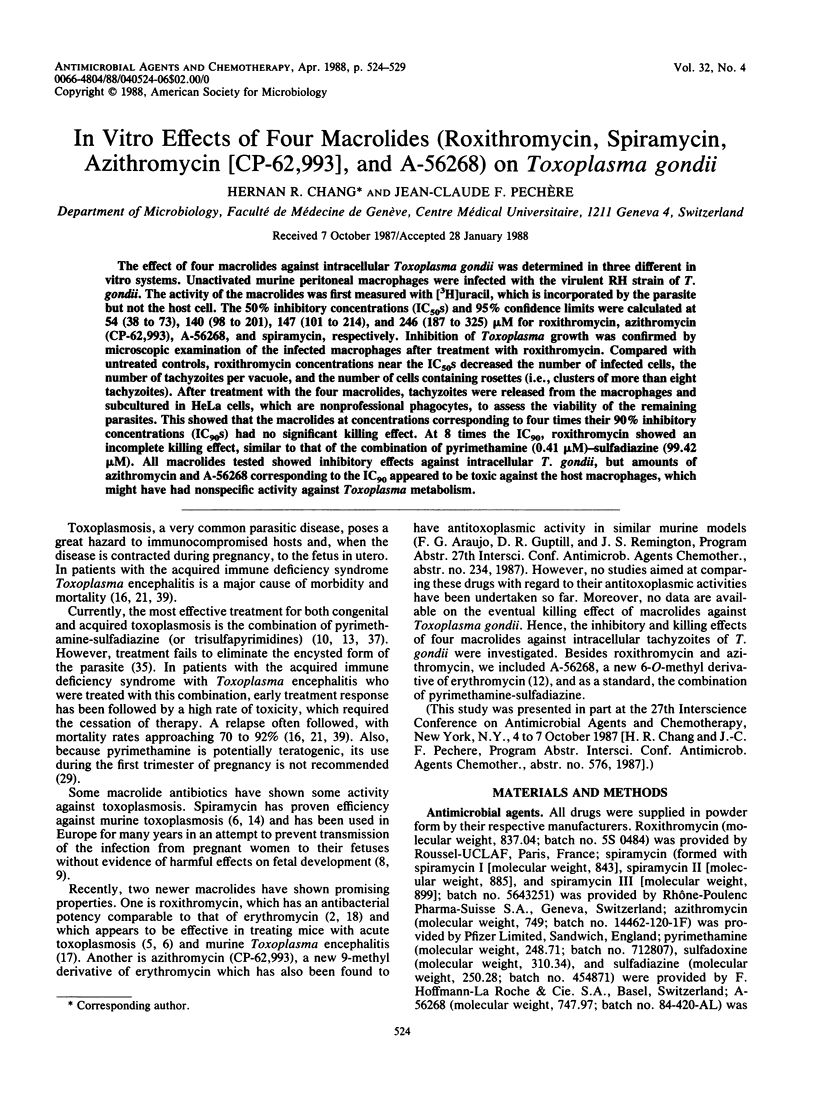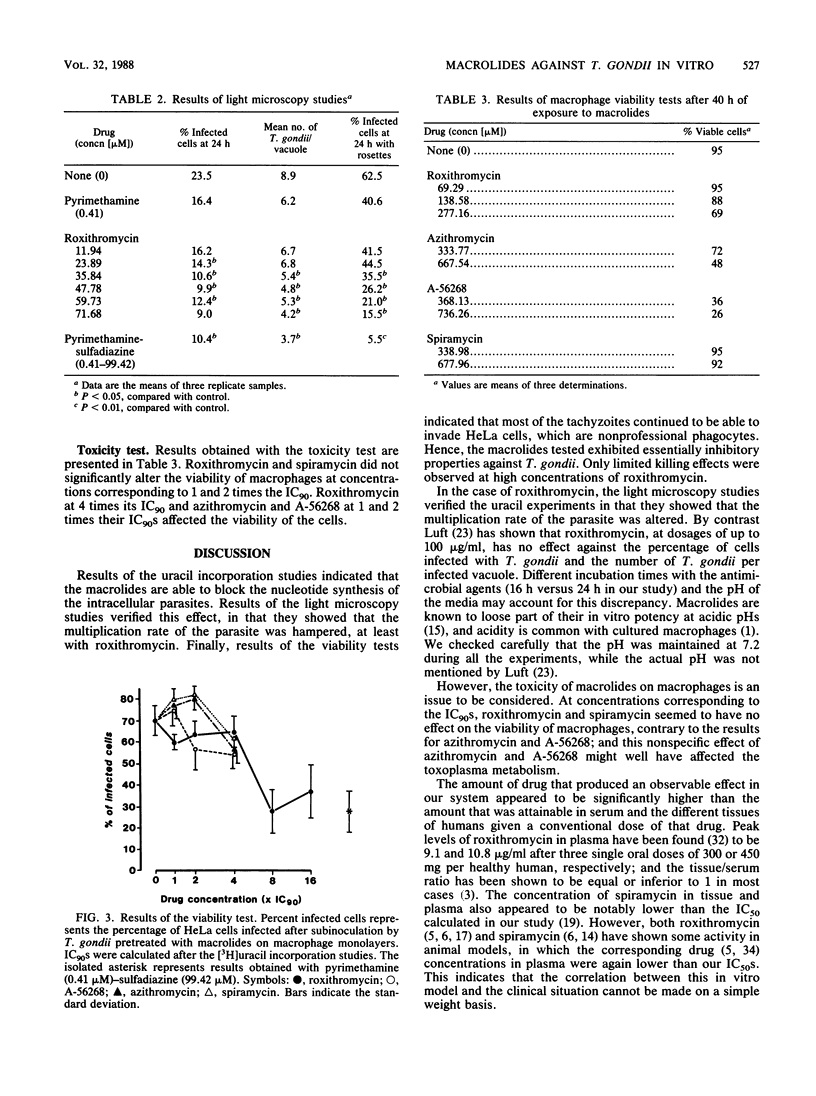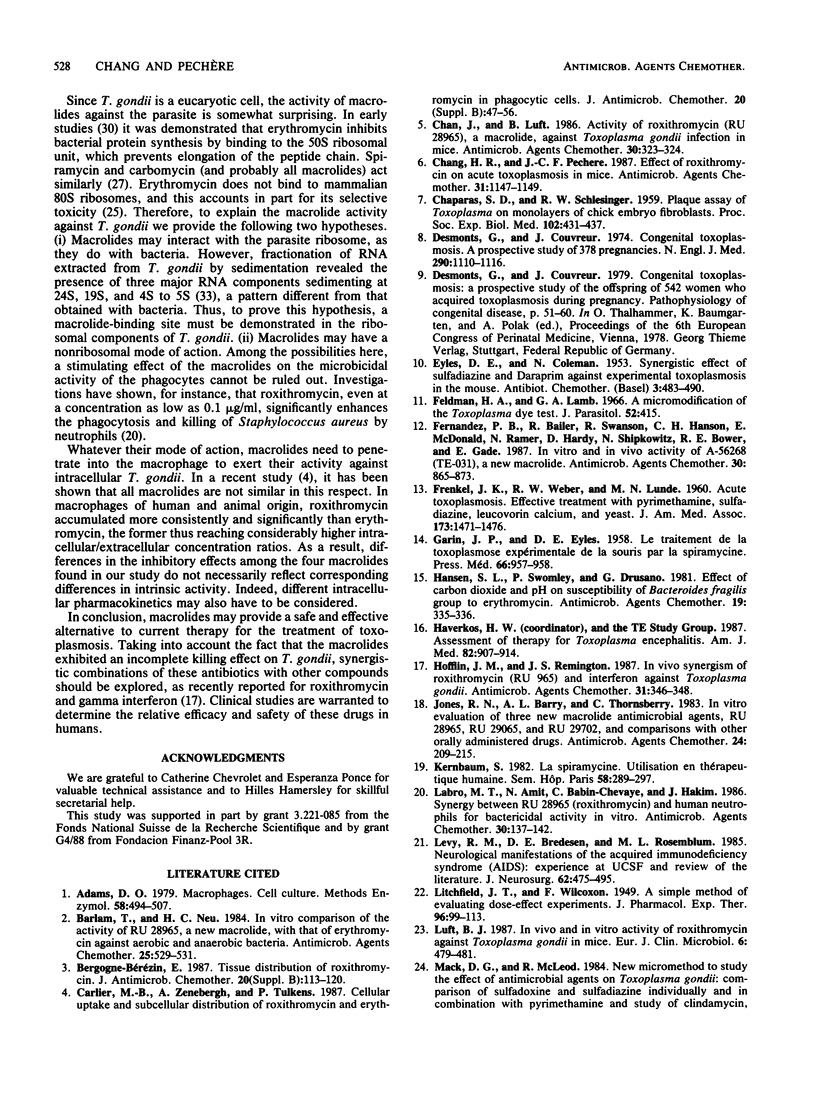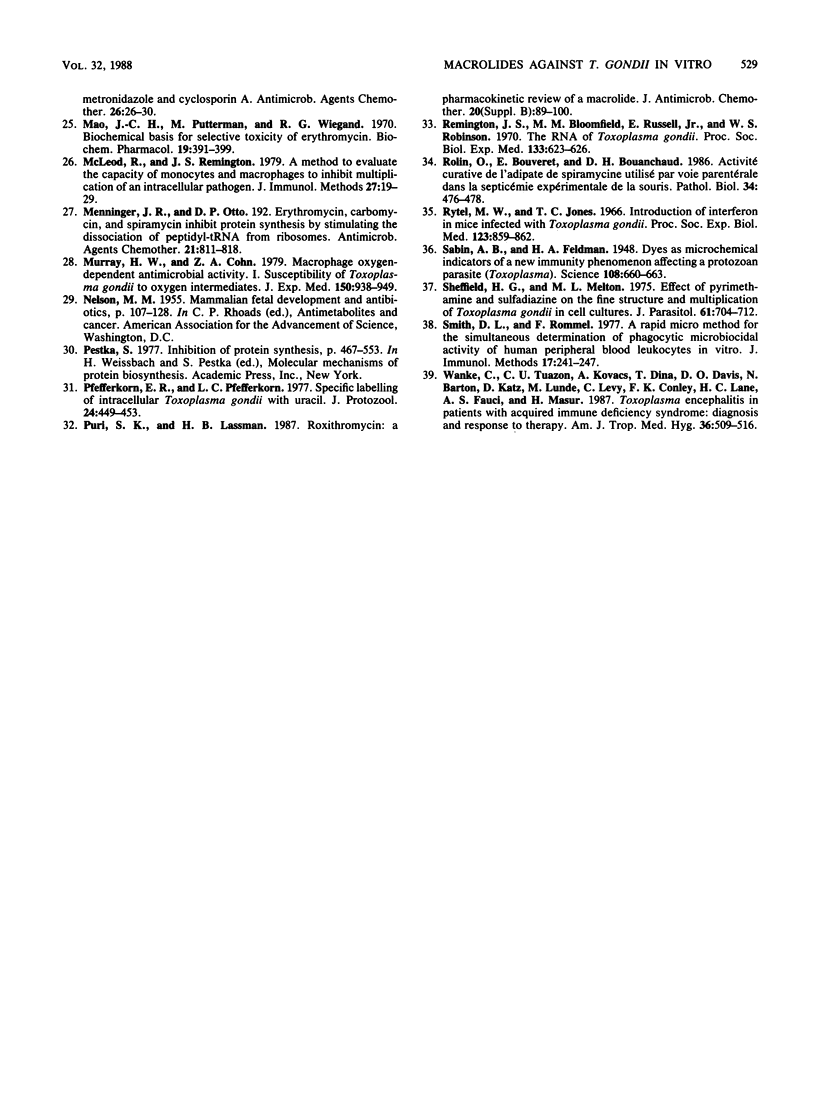Abstract
The effect of four macrolides against intracellular Toxoplasma gondii was determined in three different in vitro systems. Unactivated murine peritoneal macrophages were infected with the virulent RH strain of T. gondii. The activity of the macrolides was first measured with [3H]uracil, which is incorporated by the parasite but not the host cell. The 50% inhibitory concentrations (IC50s) and 95% confidence limits were calculated at 54 (38 to 73), 140 (98 to 201), 147 (101 to 214), and 246 (187 to 325) micron for roxithromycin, azithromycin (CP-62,993), A-56268, and spiramycin, respectively. Inhibition of Toxoplasma growth was confirmed by microscopic examination of the infected macrophages after treatment with roxithromycin. Compared with untreated controls, roxithromycin concentrations near the IC50s decreased the number of infected cells, the number of tachyzoites per vacuole, and the number of cells containing rosettes (i.e., clusters of more than eight tachyzoites). After treatment with the four macrolides, tachyzoites were released from the macrophages and subcultured in HeLa cells, which are nonprofessional phagocytes, to assess the viability of the remaining parasites. This showed that the macrolides at concentrations corresponding to four times their 90% inhibitory concentrations (IC90s) had no significant killing effect. At 8 times the IC90, roxithromycin showed an incomplete killing effect, similar to that of the combination of pyrimethamine (0.41 microM)-sulfadiazine (99.42 microM). All macrolides tested showed inhibitory effects against intracellular T. gondii, but amounts of azithromycin and A-56268 corresponding to the IC90 appeared to be toxic against the host macrophages, which might have had nonspecific activity against Toxoplasma metabolism.
Full text
PDF





Selected References
These references are in PubMed. This may not be the complete list of references from this article.
- Adams D. O. Macrophages. Methods Enzymol. 1979;58:494–505. doi: 10.1016/s0076-6879(79)58164-6. [DOI] [PubMed] [Google Scholar]
- Barlam T., Neu H. C. In vitro comparison of the activity of RU 28965, a new macrolide, with that of erythromycin against aerobic and anaerobic bacteria. Antimicrob Agents Chemother. 1984 Apr;25(4):529–531. doi: 10.1128/aac.25.4.529. [DOI] [PMC free article] [PubMed] [Google Scholar]
- Bergogne-Bérézin E. Tissue distribution of roxithromycin. J Antimicrob Chemother. 1987 Nov;20 (Suppl B):113–120. doi: 10.1093/jac/20.suppl_b.113. [DOI] [PubMed] [Google Scholar]
- CHAPARAS S. D., SCHLESINGER R. W. Plaque assay of Toxoplasma on monolayers of chick embryo fibroblasts. Proc Soc Exp Biol Med. 1959 Nov;102:431–437. doi: 10.3181/00379727-102-25275. [DOI] [PubMed] [Google Scholar]
- Carlier M. B., Zenebergh A., Tulkens P. M. Cellular uptake and subcellular distribution of roxithromycin and erythromycin in phagocytic cells. J Antimicrob Chemother. 1987 Nov;20 (Suppl B):47–56. doi: 10.1093/jac/20.suppl_b.47. [DOI] [PubMed] [Google Scholar]
- Chan J., Luft B. J. Activity of roxithromycin (RU 28965), a macrolide, against Toxoplasma gondii infection in mice. Antimicrob Agents Chemother. 1986 Aug;30(2):323–324. doi: 10.1128/aac.30.2.323. [DOI] [PMC free article] [PubMed] [Google Scholar]
- Chang H. R., Pechere J. C. Effect of roxithromycin on acute toxoplasmosis in mice. Antimicrob Agents Chemother. 1987 Jul;31(7):1147–1149. doi: 10.1128/aac.31.7.1147. [DOI] [PMC free article] [PubMed] [Google Scholar]
- Desmonts G., Couvreur J. Congenital toxoplasmosis. A prospective study of 378 pregnancies. N Engl J Med. 1974 May 16;290(20):1110–1116. doi: 10.1056/NEJM197405162902003. [DOI] [PubMed] [Google Scholar]
- FRENKEL J. K., WEBER R. W., LUNDE M. N. Acute toxoplasmosis. Effective treatment with pyrimethamine, sulfadiazine, leucovorin calcium, and yeast. JAMA. 1960 Jul 30;173:1471–1476. doi: 10.1001/jama.1960.03020310059017. [DOI] [PubMed] [Google Scholar]
- Fernandes P. B., Bailer R., Swanson R., Hanson C. W., McDonald E., Ramer N., Hardy D., Shipkowitz N., Bower R. R., Gade E. In vitro and in vivo evaluation of A-56268 (TE-031), a new macrolide. Antimicrob Agents Chemother. 1986 Dec;30(6):865–873. doi: 10.1128/aac.30.6.865. [DOI] [PMC free article] [PubMed] [Google Scholar]
- GARIN J. P., EYLES D. E. Le traitement de la toxoplasmose expérimentale de la souris par la spiramycine. Presse Med. 1958 May 28;66(42):957–958. [PubMed] [Google Scholar]
- Hansen S. L., Swomley P., Drusano G. Effect of carbon dioxide and pH on susceptibility of Bacteroides fragilis group to erythromycin. Antimicrob Agents Chemother. 1981 Feb;19(2):335–336. doi: 10.1128/aac.19.2.335. [DOI] [PMC free article] [PubMed] [Google Scholar]
- Haverkos H. W. Assessment of therapy for toxoplasma encephalitis. The TE Study Group. Am J Med. 1987 May;82(5):907–914. doi: 10.1016/0002-9343(87)90151-3. [DOI] [PubMed] [Google Scholar]
- Hofflin J. M., Remington J. S. In vivo synergism of roxithromycin (RU 965) and interferon against Toxoplasma gondii. Antimicrob Agents Chemother. 1987 Feb;31(2):346–348. doi: 10.1128/aac.31.2.346. [DOI] [PMC free article] [PubMed] [Google Scholar]
- Jones R. N., Barry A. L., Thornsberry C. In vitro evaluation of three new macrolide antimicrobial agents, RU28965, RU29065, and RU29702, and comparisons with other orally administered drugs. Antimicrob Agents Chemother. 1983 Aug;24(2):209–215. doi: 10.1128/aac.24.2.209. [DOI] [PMC free article] [PubMed] [Google Scholar]
- Kernbaum S. La spiramycine. Utilisation en thérapeutique humaine. Sem Hop. 1982 Feb 4;58(5):289–297. [PubMed] [Google Scholar]
- LITCHFIELD J. T., Jr, WILCOXON F. A simplified method of evaluating dose-effect experiments. J Pharmacol Exp Ther. 1949 Jun;96(2):99–113. [PubMed] [Google Scholar]
- Labro M. T., Amit N., Babin-Chevaye C., Hakim J. Synergy between RU 28965 (roxithromycin) and human neutrophils for bactericidal activity in vitro. Antimicrob Agents Chemother. 1986 Jul;30(1):137–142. doi: 10.1128/aac.30.1.137. [DOI] [PMC free article] [PubMed] [Google Scholar]
- Levy R. M., Bredesen D. E., Rosenblum M. L. Neurological manifestations of the acquired immunodeficiency syndrome (AIDS): experience at UCSF and review of the literature. J Neurosurg. 1985 Apr;62(4):475–495. doi: 10.3171/jns.1985.62.4.0475. [DOI] [PubMed] [Google Scholar]
- Luft B. J. In vivo and in vitro activity of roxithromycin against Toxoplasma gondii in mice. Eur J Clin Microbiol. 1987 Aug;6(4):479–481. doi: 10.1007/BF02013115. [DOI] [PubMed] [Google Scholar]
- Mao J. C., Putterman M., Wiegand R. G. Biochemical basis for the selective toxicity of erythromycin. Biochem Pharmacol. 1970 Feb;19(2):391–399. doi: 10.1016/0006-2952(70)90194-2. [DOI] [PubMed] [Google Scholar]
- McLeod R., Remington J. S. A method to evaluate the capacity of monocytes and macrophages to inhibit multiplication of an intracellular pathogen. J Immunol Methods. 1979 May 10;27(1):19–29. doi: 10.1016/0022-1759(79)90235-7. [DOI] [PubMed] [Google Scholar]
- Murray H. W., Cohn Z. A. Macrophage oxygen-dependent antimicrobial activity. I. Susceptibility of Toxoplasma gondii to oxygen intermediates. J Exp Med. 1979 Oct 1;150(4):938–949. doi: 10.1084/jem.150.4.938. [DOI] [PMC free article] [PubMed] [Google Scholar]
- Pfefferkorn E. R., Pfefferkorn L. C. Specific labeling of intracellular Toxoplasma gondii with uracil. J Protozool. 1977 Aug;24(3):449–453. doi: 10.1111/j.1550-7408.1977.tb04774.x. [DOI] [PubMed] [Google Scholar]
- Puri S. K., Lassman H. B. Roxithromycin: a pharmacokinetic review of a macrolide. J Antimicrob Chemother. 1987 Nov;20 (Suppl B):89–100. doi: 10.1093/jac/20.suppl_b.89. [DOI] [PubMed] [Google Scholar]
- Remington J. S., Bloomfield M. M., Russell E., Jr, Robinson W. S. The RNA of toxoplasma gondii. Proc Soc Exp Biol Med. 1970 Feb;133(2):623–626. doi: 10.3181/00379727-133-34531. [DOI] [PubMed] [Google Scholar]
- Rolin O., Bouveret E., Bouanchaud D. H. Activité curative de l'adipate de spiramycine utilisé par voie parentérale dans la septicémie expérimentale de la souris. Comparaison avec la spiramycine base administrée par voie orale. Pathol Biol (Paris) 1986 May;34(5):476–478. [PubMed] [Google Scholar]
- Rytel M. W., Jones T. C. Induction of interferon in mice infected with Toxoplasma gondii. Proc Soc Exp Biol Med. 1966 Dec;123(3):859–862. doi: 10.3181/00379727-123-31624. [DOI] [PubMed] [Google Scholar]
- Sabin A. B., Feldman H. A. Dyes as Microchemical Indicators of a New Immunity Phenomenon Affecting a Protozoon Parasite (Toxoplasma). Science. 1948 Dec 10;108(2815):660–663. doi: 10.1126/science.108.2815.660. [DOI] [PubMed] [Google Scholar]
- Sheffield H. G., Melton M. L. Effect of pyrimethamine and sulfadiazine on the fine structure and multiplication of Toxoplasma gondii in cell cultures. J Parasitol. 1975 Aug;61(4):704–712. [PubMed] [Google Scholar]
- Smith D. L., Rommel F. A rapid micro method for the simultaneous determination of phagocytic-microbiocidal activity of human peripheral blood leukocytes in vitro. J Immunol Methods. 1977;17(3-4):241–247. doi: 10.1016/0022-1759(77)90106-5. [DOI] [PubMed] [Google Scholar]
- Wanke C., Tuazon C. U., Kovacs A., Dina T., Davis D. O., Barton N., Katz D., Lunde M., Levy C., Conley F. K. Toxoplasma encephalitis in patients with acquired immune deficiency syndrome: diagnosis and response to therapy. Am J Trop Med Hyg. 1987 May;36(3):509–516. doi: 10.4269/ajtmh.1987.36.509. [DOI] [PubMed] [Google Scholar]


